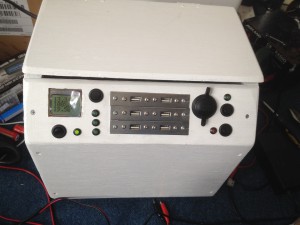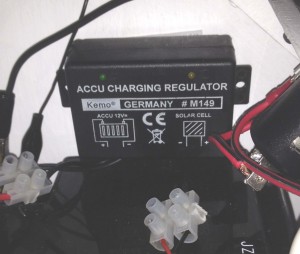Power Box V3 – First proper use performance
 My recent holiday to Le Mans was the first time I’ve been able to properly test the new power box I built a few months ago. For those who haven’t followed the project the idea was to make a smaller more manageable box (one I could pick up without breaking my back) and one that had more USB sockets on it for charging devices. I also added a way to charge it through solar panels which came in very useful on this holiday.
My recent holiday to Le Mans was the first time I’ve been able to properly test the new power box I built a few months ago. For those who haven’t followed the project the idea was to make a smaller more manageable box (one I could pick up without breaking my back) and one that had more USB sockets on it for charging devices. I also added a way to charge it through solar panels which came in very useful on this holiday.
I’ll start off by saying it performed better than I expected. There were 7 of us during the Le Mans trip and we were all charging something during the day whilst we were on camp. It charged phones and my tablet as designed, plus through the inverter, a Nintendo DS and a Laptop of some guys who caught up with us later in the week whilst they were travelling the country.
During the week I had my solar panels set up. At the moment I have a 10 watt panel and a 20 watt panel which are in parallel to give 30 watts. In order to use the panels I had to add a small charge controller to the box so that the battery didn’t get overcharged by the panels once it was full. This was a small modification that I planned to do once it was ready.
The charge controller is nothing special. It’s something I picked up years ago from Maplin when I was first getting into solar charging. Once it gets to 14.2v it cuts off charging and it comes back on again once it drops below 13.2v. It’s not a clever unit like some you can buy that pulse-width the charging to hold the charging voltage. These work much better than my unit, but they also cost more.
Now, 30 watts isn’t a lot but for such a small power drain as charging phones it was more than enough. The battery was almost fully charged every day even when using the laptop on the inverter for small bursts. At full output the panels can charge at 1.7A (at 12.8v this is almost 22w but since panels are optimised for 17v, 30w is not achievable without a different charge controller, but that’s another story). 22w is the maximum output I can expect from the 2 panels combined and I think this was regularly reached when we were in Le Mans.
It was certainly the center of attention for one person in the group who kept calling it her “pixie box”, and she kept asking if she could have some pixies for her Nintendo DS! Of course, I obliged!
The one issue I did have when charging is that all the micro USB cables I have seem to be broken or duff in some way. None of them seem capable of charging my phone whilst it is in use. It’s nothing to do with the box which can happily supply the power as I discovered it happens at home too! I’ve ordered a new cable to hopefully fix this. If it doesn’t fix it then I’ll assume it’s my battery booster case on my iPhone causing it.
All in all it was a success. The panels did their job keeping the box charged and it provided plenty of power for everyone to charge their phones.

